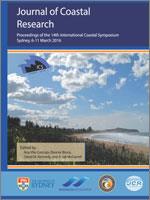Yang, Z.T.; Li, H.J.; Liang, B.C.; Lee, D.Y.; Pan, X.Y., and Xu, Y., 2016. Laboratory experiment on the bed load sediment transport over rippled bed. In: Vila-Concejo, A.; Bruce, E.; Kennedy, D.M., and McCarroll, R.J. (eds.), Proceedings of the 14th International Coastal Symposium (Sydney, Australia). Journal of Coastal Research, Special Issue, No. 75, pp. 497–501. Coconut Creek (Florida), ISSN 0749-0208.
Bed load sediment transport over rippled bedforms was investigated through a series of laboratory experiments with different combinations of bed slope, grain size, wave conditions and water level using a 2D wave flume. In addition to the measurement of surface waves and velocity, the water surface and bottom bed elevation were precisely monitored using video cameras to record the continuous processes of profile evolution, including ripple formation and migration under the assumption of longshore uniformity. The bed load sediment transport flux associated with ripple migration was then estimated. Numerical model SWASH was applied to provide representative forcing hydrodynamic parameters in the estimation of sediment flux where measurement data was scarce after proper validation. It was observed that ripples migrate with an average speed of 0.113 mm/s, and bed load sediment flux of 0.0061kg m−1 s−1 respectively. Velocity skewness explains the highest correlation with ripple migration speed for all cases, while mean flow appears to be dominant in the coarser sand transport. Good agreement was found from comparisons of sediment transport flux between measurements derived from ripple migration and semi-empirical bed load transport formulations.





